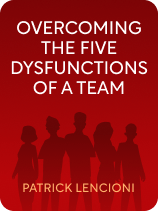

This article is an excerpt from the Shortform book guide to "Overcoming the Five Dysfunctions of a Team" by Patrick Lencioni. Shortform has the world's best summaries and analyses of books you should be reading.
Like this article? Sign up for a free trial here.
How much do people get away with on your team? Which is more effective—accountability from managers or colleagues?
Patrick Lencioni addresses the issue of accountability in both of his books about team dysfunctions, identifying the avoidance of accountability as the fourth dysfunction. He says that it’s much easier to call people out on results than behaviors, but the latter is far more important.
Continue reading for Lencioni’s advice on overcoming the avoidance of accountability in a team.
Accountability in a Team
Lencioni explains that accountability involves team members—including the team leader—holding each other responsible for their behavior and their results. It can be uncomfortable, but the avoidance of accountability in a team inevitably leads to poor performance.
Holding people accountable for their results is easy. If there are clear expectations regarding, say, sales numbers or company profits, it’s easy to tell when someone isn’t meeting them. In that case, there needs to be a conversation about why they’re falling short and how to address the problem.
Lencioni says it’s much more uncomfortable to hold people accountable for their day-to-day behavior. But, it’s just as important because behavior leads directly to results; by correcting behaviors, you can stop poor results from happening in the first place. For example, if one of your team members seems disengaged or hostile during team meetings, that bad behavior might also come through when they’re talking to customers, thereby harming sales.
| Accountability Through the “What Happened” Conversation Holding people accountable, whether for their behaviors or their outcomes, often requires uncomfortable and difficult conversations. It may help to have a plan for handling these discussions. In Difficult Conversations, the authors call this the “what happened” conversation, and they explain how to approach it productively. The key to a successful “what happened” conversation is to approach it with curiosity instead of judgment. Your goal should be to find out what’s wrong—in this case, to find the cause of the team member’s poor behavior or poor performance—not to accuse or shame the other person. To learn what the problem is, start by explaining your perspective: The team member isn’t meeting expectations, or they’re engaging in a concerning behavior. Then, show curiosity by asking for the other person’s perspective on why the issue is happening. For example, they might reveal that a problem in their personal life is distracting them at work or that they’re having problems with another team member. Then, the two of you can work together to figure out the best way to address that problem. |
How to Overcome the Avoidance of Accountability
According to Lencioni, to help your team overcome their fear of holding each other accountable, you must first help them realize that it’s really the fear of hurting each other. Accountability is personal—as a result, calling out your teammates’ shortcomings often feels judgmental and unkind. This holds true for the team leader and team members alike.
Once you understand where this dysfunction comes from, you can start taking steps to overcome it. Specifically, change your team’s mindset: Explain that failing to hold each other accountable is much more harmful than the brief discomfort of a difficult conversation. Holding back criticism doesn’t just harm the company—it also robs team members of the chance to improve.
Lencioni adds that the most effective type of accountability is between teammates. This is because criticism feels more personal and more meaningful when it comes from a peer instead of from “the boss” (the team leader), who’s in a position where giving feedback and criticism is just part of their job. Therefore, overcoming the avoidance of accountability—empowering team members to give each other feedback—is more effective than any feedback the leader could give personally.
(Shortform note: In No Rules Rules, Netflix co-founder and executive chairman Reed Hastings says that the best way to make sure people feel comfortable giving (and getting) feedback is to create a company culture where anyone can give feedback to anyone else, at any time. This eliminates the uncertainty about whether and when it’s acceptable to give someone negative feedback. It also helps minimize the power dynamic that Lencioni notes, where feedback from “the boss” doesn’t feel as meaningful or as personal as feedback from a peer. In this case, feedback from a peer will be just as common as feedback from the manager or team leader, so one won’t feel any more personal or unusual than the other.)
| Holding Back Criticism Is a Lie by Omission Another way to help your team push through their avoidance of accountability is to share that holding back important criticism is the same thing as lying. Specifically, it’s a lie by omission, since you’re pretending everything is OK when it actually isn’t, and that people don’t need to improve when they do. Lies by omission are just as hurtful as actually saying something untrue, even if you’re trying to protect someone else’s feelings by withholding your feedback. Furthermore, just like any other type of lie, lies by omission quickly erode trust—teammates need to trust each other to tell the whole truth, not just the positive parts of it. So, even though a person might just be trying to keep their teammate happy, they could be doing serious harm to the team as a whole, and, by extension, the company. |

———End of Preview———
Like what you just read? Read the rest of the world's best book summary and analysis of Patrick Lencioni's "Overcoming the Five Dysfunctions of a Team" at Shortform.
Here's what you'll find in our full Overcoming the Five Dysfunctions of a Team summary:
- What "teamwork" actually means, and how to foster it
- Why trust is the most important element in an effective team
- The five impairments to teamwork and how to overcome them






